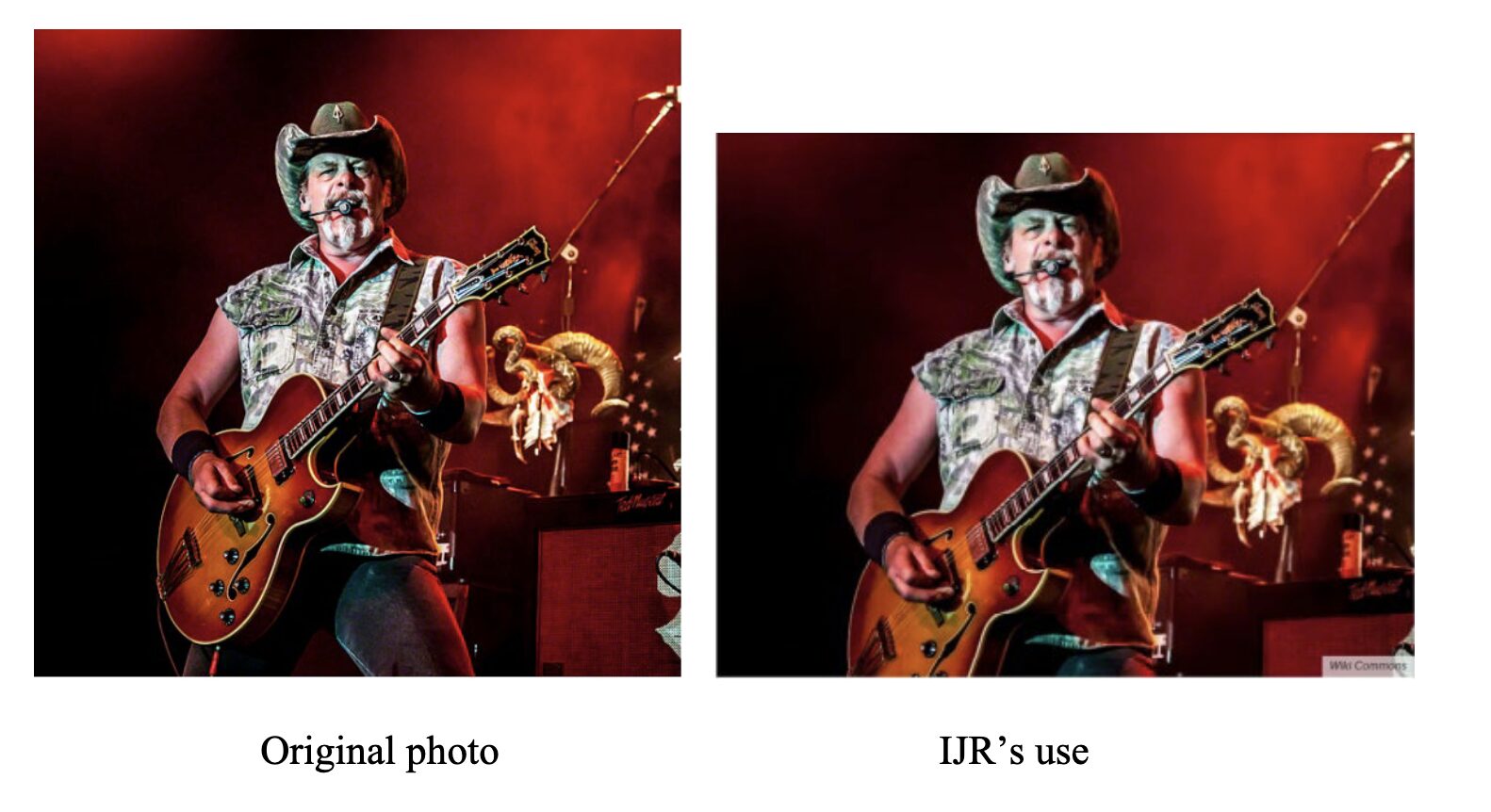“To be sure, the article was not especially profitable for IJR… But the salient question is whether IJR stood to profit, not whether it was particularly successful at that venture.” – Fourth Circuit opinion

Source: U.S. Court of Appeals for the Fourth Circuit decision.
On February 6, the U.S. Court of Appeals for the Fourth Circuit issued an opinion in Philpot v. Independent Journal Review reversing a ruling that an online reproduction of a photograph of singer-songwriter Ted Nugent constituted fair use. The Fourth Circuit further found that professional photographer Larry Philpot was entitled to summary judgment on the validity of his copyright registration, vacating the Eastern District of Virginia’s determination that a genuine dispute of material fact existed as to the accuracy of Philpot’s registration application.
Philpot filed his copyright infringement lawsuit against the Independent Journal Review (IJR) in May 2020, about four years after IJR published a Nugent photograph captured by Philpot in an online article entitled “15 Signs Your Daddy Was a Conservative.” IJR moved for summary judgment, arguing that its use of the photo was transformative under 17 U.S.C. § 107 and that Philpot’s copyright registration inaccurately identified the Nugent photo as unpublished. While the Eastern Virginia district court did not grant summary judgment on the registration validity issue, the court did find a transformative fair use of Philpot’s photograph due to the new context created by the online article.
District Court’s Transformative Use Finding Fails Under Goldsmith’s Reasoning
In analyzing the four fair use factors codified at Section 107, the Fourth Circuit instead found that each of the factors weighed against a finding that IJR’s infringing use was fair. In assessing the first factor, the purpose and character of the use, the appellate court’s reasoning relied heavily upon the U.S. Supreme Court’s recent fair use ruling in Andy Warhol Foundation v. Goldsmith (2023). Similar to Warhol’s Orange Prince print that ultimately infringed upon a Prince photograph captured by Lynn Goldsmith, the Fourth Circuit found that IJR’s and Philpot’s uses shared the same purpose: creating a depiction of Ted Nugent. The appellate court further noted that, unlike in Goldsmith, the Nugent photograph at issue in this case was not recolored or otherwise altered to create new expression.
The district court’s transformative use finding further did not accord with previous Fourth Circuit precedent, the appellate court ruled. In Brammer v. Violent Hues Productions (2018), the Fourth Circuit found that a film company’s use of a stock photo image of a neighborhood in Washington, D.C., was not transformative even if placed in a “new context to serve a different purpose,” which in that case was to promote a Virginia film and music festival. Similarly, IJR’s secondary use of Philpot’s Nugent photograph had no new purpose or meaning with only minimal alterations.
Concluding its analysis of the first fair use factor, the Fourth Circuit also disagreed with the Eastern Virginia district court’s finding that IJR’s use was noncommercial. “To be sure, the article was not especially profitable for IJR,” the Fourth Circuit wrote, noting that IJR earned at most $3 in advertising revenue from the article using the Nugent photograph. “But the salient question is whether IJR stood to profit, not whether it was particularly successful at that venture,” the appellate court pointed out.
Although the district court did not assess the second and third fair use factors, the Fourth Circuit found that those factors also weighed against IJR. The nature of the copyrighted work includes several of Philpot’s creative choices such that the work merits thick copyright protection, the appellate court found. In assessing the amount and substantiality of the portion of Philpot’s work used by IJR, the Fourth Circuit held that IJR only cropped out negative space from the photograph. Finally, the appellate court found that IJR’s use harmed the potential market for Philpot’s use. Even though Philpot made the Nugent photograph available for free through Creative Commons in return for attribution, the Fourth Circuit pointed out that Philpot had entered into licensing agreements valued at $3,500 to $4,500 to image collections including the Nugent photograph.
License Agreement with Select Class for Limited Purpose Not a Publication
Moving on to whether Philpot filed an accurate application for copyright registration, the Fourth Circuit stated that, to qualify as a publication, the work must be held out to the public at large rather than distributed to a definitely selected class of persons for a limited purpose. At the district court level, it was found that Philpot entered into an agreement with AXS TV, an entity not involved in the present appeal, to license images including the Nugent photograph about one week prior to filing a group registration for unpublished works. The question remaining for trial was whether publication had occurred as of either the AXS TV license agreement or the delivery of the Nugent photograph, which took place after Philpot filed his group registration application.
The Fourth Circuit underscored that the relevant legal question was whether the agreement constituted an offer to distribute that satisfied the Copyright Act’s definition of publication. Applying California state law pursuant to a choice of law provision in the agreement, the Fourth Circuit found that the plain language of the agreement only gave AXS TV the right to review a catalog of 1,000 images to select 12 images for further licensing. The appellate court found that the agreement implicitly denied AXS TV the right to distribute without Philpot’s further permission, thus the agreement was not a publication of the Nugent photograph.
After vacating the Eastern Virginia district court’s summary judgment rulings, the Fourth Circuit remanded for further proceedings consistent with its opinion.

![[IPWatchdog Logo]](https://ipwatchdog.com/wp-content/themes/IPWatchdog%20-%202023/assets/images/temp/logo-small@2x.png)

![[Advertisement]](https://ipwatchdog.com/wp-content/uploads/2024/04/UnitedLex-May-2-2024-sidebar-700x500-1.jpg)
![[Advertisement]](https://ipwatchdog.com/wp-content/uploads/2024/04/Artificial-Intelligence-2024-REPLAY-sidebar-700x500-corrected.jpg)
![[Advertisement]](https://ipwatchdog.com/wp-content/uploads/2024/04/Patent-Litigation-Masters-2024-sidebar-700x500-1.jpg)

![[Advertisement]](https://ipwatchdog.com/wp-content/uploads/2021/12/WEBINAR-336-x-280-px.png)
![[Advertisement]](https://ipwatchdog.com/wp-content/uploads/2021/12/2021-Patent-Practice-on-Demand-recorded-Feb-2021-336-x-280.jpg)
![[Advertisement]](https://ipwatchdog.com/wp-content/uploads/2021/12/Ad-4-The-Invent-Patent-System™.png)






Join the Discussion
No comments yet. Add my comment.
Add Comment